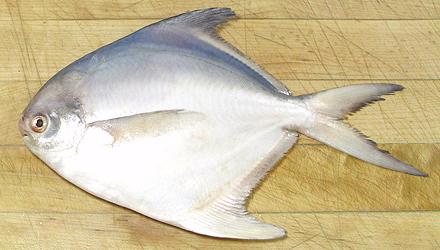 [Silver Pomfret; Pompano (Philippine); Butterfish; Pampus argenteus
| similar: Chinese Silver Pomfret Pampus chinensis]
[Silver Pomfret; Pompano (Philippine); Butterfish; Pampus argenteus
| similar: Chinese Silver Pomfret Pampus chinensis]
This tropical Indo-West Pacific fish is found near coasts from the Persian Gulf to Borneo, and as far north as mid Japan, but not as far south as Australia. It is not actually a pomfret but a butterfish. It can grow to 23 inches but the photo specimen, wild caught in India, was 10 inches and weighed 9-1/2 ounces, a typical market size here in Los Angeles. This is a major commercial catch within its range. IUCN rated "Not Evaluated", White Pomfret is not considered threatened. It is, in fact, expected to have extended its range by 2050.
Pampus chinensis is very similar but the tail is generally not so deeply forked. It is smaller, has a smaller range and is a minor commercial catch.
More on Butterfish.
"Pomfret" is one of the most sought after fish in India and Southeast Asia due to it's delicate white flesh with subtle "non-fishy" flavor. The flesh breaks up easily on the plate but not along distinct flake lines. It holds together well enough to poach fillets (skin off) but that isn't a usual way to prepare this fish. Fillets are too thin and tender for soup.
Steamed whole with a few diagonal slashes through the skin, this fish remains attractive and is quite manageable on the plate compared to many. The fin rays hold together fairly well and there are few ribs to deal with. It will also bake very nicely with the same diagonal slashes through the skin.
This fish is often deep fried whole, but must be handled carefully to avoid breaking up. A half pounder fits well in a wok with oil about 1-1/2 inch deep in the center or in a skillet with oil about 3/4 inch deep. Heat oil to 375°F and fry 5 minutes on one side, turn carefully and fry 3 minutes on the other side.
Buying: This fish can often be found in Asian fish markets serving Philippine, Chinese and Southeast Asian communities. This is a premium fish, but the price has declined with rising supply and is now around 2016 US $3.99 / pound as whole, uncleaned fish in Philippine fish markets in Los Angeles.
Scales: This fish may be covered with minute bright silver scales, but they rub off so easily there may be only patches. Fish marketed here in Los Angeles generally have only a small patch protected by the pectoral fins, if that.
Cleaning: This would be easier with the head off, but this fish is often used head-on. Make an incision from the vent (almost directly below the root of the pectoral fins) forward to under the chin. There is a stiff keel, so you may need to cut just a tiny bit off center. This will give enough access to get a couple fingers in to scrape out the innards, which extend very high and a little aft of the vent. Scrape the gills loose at the bottom through the body cavity and pull them out through the gill slits with long nose pliers.
Fillet: While this fish is most often used whole, it is not difficult to fillet, if that's what you want, and yield is good. Remove the head and outline the fillet by cutting through the skin top, bottom and over the tail. Cut from top front to back, then over the tail and work forward. When you get to the rib cage, just pull the fillet off the ribs. Examine it carefully for remaining ribs and fin rays. There may be one or two centerline pin bones.
Yield: A 10 inch 9-1/2 ounce fish yielded 6 ounces skin-on (63%) and 5-1/4 ounces (55%). Yield is quite good due to the very small head.
Skin: Fillets are difficult to skin because the skin has very good adherence, and it is difficult to feel the divide between skin and flesh. Fortunately it would need to be removed only for poaching, which is not a usual use for this fish. The skin has a stronger taste than the flesh, but not annoyingly so. Skin shrink is definite, but fillets, lightly dusted with rice flour, can be pan fried skin-on. When the fillet is turned skin-side down, press it down with your turner. The skin will soon soften and the fillet will remain flat (though thicker than it started out). After cooking, particularly frying, the skin can easily be peeled off if desired, but there's really no reason to do so.
Stock: The heads, bones and fins, simmered slowly for 40 minutes, make a very usable mild stock, almost clear and with just a hint of color. For details see our recipe Fish Stock
sf_pomfcsz* 2006 rev 110701 - www.clovegarden.com